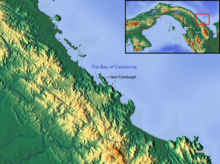| New Caledonia | |||||||||
|---|---|---|---|---|---|---|---|---|---|
| Colony of the Kingdom of Scotland | |||||||||
| 1698–1700 | |||||||||
 New Caledonia on a modern map | |||||||||
| Capital | New Edinburgh | ||||||||
| Area | |||||||||
| • Coordinates | 8°50′02.47″N 77°37′54.47″W / 8.8340194°N 77.6317972°W | ||||||||
• 1698 | 1.036 km2 (0.400 sq mi) | ||||||||
| Population | |||||||||
• 1698 | 1,200 | ||||||||
• 1700 | 2,500 | ||||||||
| Government | |||||||||
| Monarch | |||||||||
• 1689–1702 | William II | ||||||||
| Council | |||||||||
| Historical era | Colonial period | ||||||||
• Landfall | 2 November 1698 | ||||||||
• First colony abandoned | July 1699 | ||||||||
• Second colony established | 30 November 1699 | ||||||||
• Second colony abandoned | February 1700 | ||||||||
| |||||||||
| Today part of | Panama | ||||||||
| Part of a series on |
| European colonization of the Americas |
|---|
 |
|
|
The Darien scheme was an unsuccessful attempt, backed largely by investors of the Kingdom of Scotland, to gain wealth and influence by establishing New Caledonia, a colony in the Darién Gap on the Isthmus of Panama, in the late 1690s. The plan was for the colony, located on the Gulf of Darién, to establish and manage an overland route to connect the Pacific and Atlantic Oceans. The backers knew that the first sighting of the Pacific Ocean by Vasco Núñez de Balboa was after crossing the isthmus through Darién. The expedition also claimed sovereignty over "Crab Isle" (modern day Vieques, Puerto Rico) in 1698, yet sovereignty was short-lived.[2] The attempt at settling the area did not go well; more than 80 percent of participants died within a year, and the settlement was abandoned twice.[3][4]
There are many explanations for the disaster. Rival claims have been made suggesting that the undertaking was beset by poor planning and provisioning; divided leadership; a lack of trade with local indigenous tribes or neighbouring Dutch and English colonies;[5] epidemics of tropical disease; widespread opposition to the scheme from commercial interests in England;[5] and a failure to anticipate a military response from the Spanish Empire. It was finally abandoned in March 1700 after a siege by Spanish forces, which also blockaded the harbour.[6]
As the Company of Scotland was backed by approximately 20 per cent of all the money circulating in Scotland, its failure left the entire Scottish Lowlands in financial ruin. This was an important factor in weakening their resistance to the Act of Union (completed in 1707).
The land where the Darien colony was built is located in the modern territory of Guna Yala, an autonomous indigenous territory home to the Guna people.
- ^ Hart, Francis Russell. (1929). The disaster of Darien: the story of the Scots settlement and the causes of its failure, 1699-1701. Boston and New York: Houghton Mifflin company.
- ^ Hidalgo, Dennis R. (January 2001). "To Get Rich for Our Homeland: The Company of Scotland and the Colonization of the Isthmus of Darien". Clahr: Colonial Latin American Historical Review.
- ^ The Week, "How Scottish Independence Vanished ..."
- ^ Little, "The Caribbean colony ..."
- ^ a b Ibeji, Mike (17 February 2011). "The Darien Venture". BBC British History. BBC. Retrieved 16 April 2017.
- ^ Monaghan, Renaissance, Reformation ..., p. 56.
